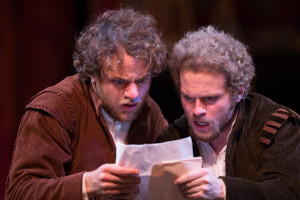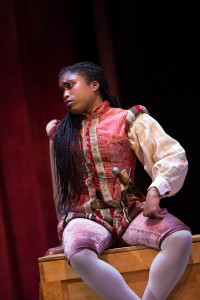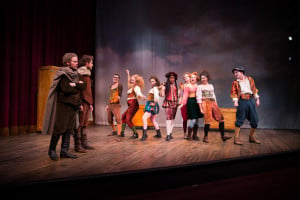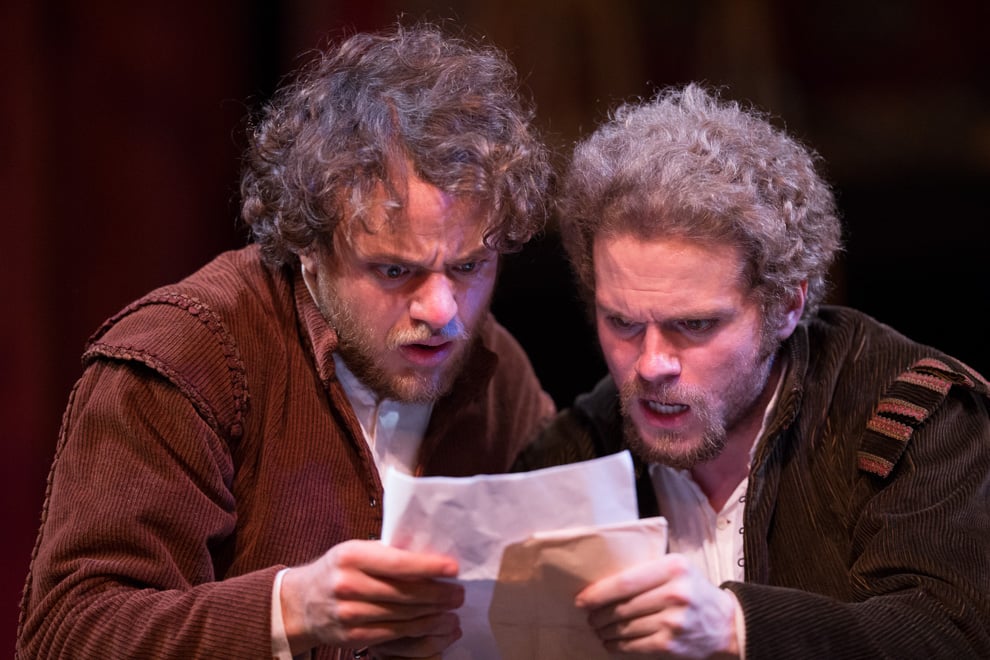Tom Stoppard’s “Rosencrantz And Guildenstern Are Dead” — which imagines the story of two of the most forgotten characters in “Hamlet” — is known for its “violent juxtapositions of the metaphysical and the hilarious,” according to director Amy Freed. Stanford TAPS’ production of the play, performed this past weekend in Pigott Theater, navigated these juxtapositions masterfully. Freed’s expert direction was aided by an impeccable cast that was at once uproariously funny and deeply attentive to the complexity of Stoppard’s language and ideas.

The two leads, Max Walker-Silverman ‘15 (Rosencrantz) and Austin Caldwell ‘15 (Guildenstern) are the heart of the play and rarely leave the stage. A scene in which they play a game of “questions,” rapidly bouncing questions off each other without answering them, demonstrates the genuine rapport these actors have with each other as well as their acumen as individual performers. In this scene, they play off each other with a true sense of fun, all while delivering complex, lyrical language in an impressive duo-juggling act.

Kasiemobi Udo-Okoye ‘15 also excels as The Player, an extravagant and flamboyant leader of a disheveled acting troupe. Udo-Okoye’s campy monologues about the decline of the theatre, delivered with sweeping gestures and a melodramatic style, are a highpoint of the production. She exclaims, “We are actors. We pledged our identities, secure in the conventions of our trade that someone would be watching. And then, gradually, no one was.” While these monologues were always amusing, they also shed light on the declining state of the theater.
The production’s parodies of “Hamlet” offer insightful critiques on issues such as class, social status and authority. Lianna Holston ’18 hysterically portrays Ophelia’s madness, incorporating loud tantrums and fake drowning. Devon Warshaw ’16, as the ridiculously brooding Hamlet, stares pensively into skulls while reciting the play’s famous lines. These moments pose the question of why stories like “Hamlet” focus on certain characters but largely ignore others – such Rosencrantz and Guildenstern. The story uses Shakespeare’s apparent indifference toward these characters to explore questions of the existential human condition – such as the arbitrary nature of status and hierarchy – and uses Hamlet’s decree to kill Rosencrantz and Guildenstern as a method of examining questions of life and death.
Freed guides the play through these weighty, existential topics with grace, but her major strength in this production is her use of comedy to illuminate these issues. Physical comedy abounds in this piece, including sight gags where the entire ensemble steps out of one box, intricate physical idiosyncrasies taken on by the mad Hamlet and Ophelia, and moments of breaking the fourth wall with the audience, such as when Max Walker-Silverman shouts “Fire!” at the audience, claiming that that he was “merely demonstrating the misuse of free speech.”

These moments are framed by stunning design. Professor Connie Strayer’s costume design, which includes Rosencrantz and Guildenstern’s luxurious flowing capes, the players’ technicolor costumes and Claudius and Gertrude’s elegant royal attire are designed with precise attention to detail. Erik Flatmo’s set, which starts as a bare stage but opens up to a fantastic multi-story castle complete with a moving staircase, serves as an exquisite playground for the actors. Cliff Caruther’s modern and even psychedelic sound design, incorporating slightly off interpretations of songs like “Stairway to Heaven,” sets the right tone for each scene and gives a modern flavor to a play already known for its modern style. The reinterpretation of classic songs in the context of this work succeeds in making the familiar seem uncanny.
“Rosencrantz and Guildenstern are Dead” is an all-around fantastic production, and its adroit use of physicality, its sleek design and its humor in the face of weighty topics elevate the play to a professional level.
“Rosencrantz and Guildenstern are Dead” was performed in repertory with “Hamlet,” which will also appear on the Pigott Theater from March 5-7 with some of the same cast members under the professional direction of Rob Melrose.
Contact Steve Rathje at srathje ‘at’ stanford.edu
